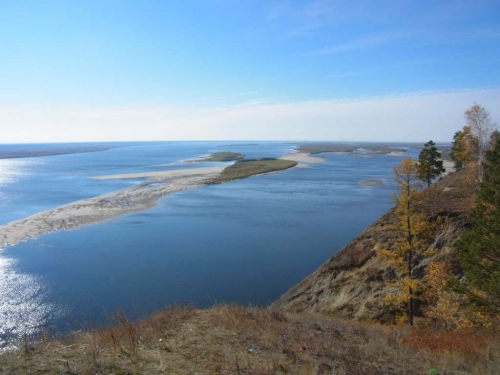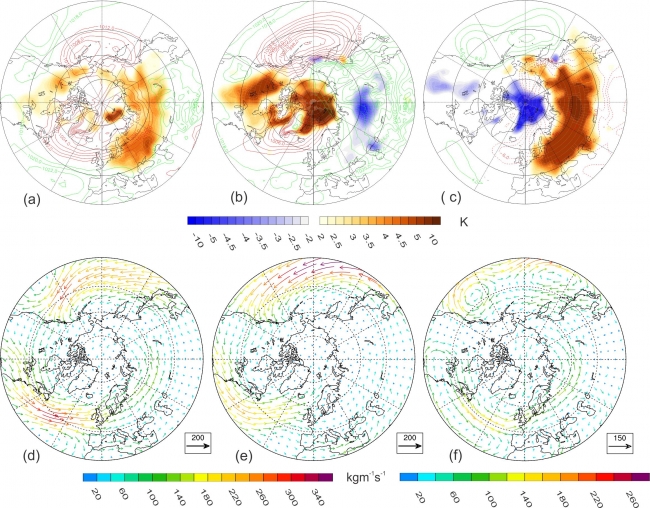A research team at the International Arctic Research Center of the University of Alaska Fairbanks has strived to improve understanding of atmospheric dynamics and their role in the rapidly changing arctic climate system. The research is funded in part by the NSF Arctic Sciences Division in collaboration with national and international scientists and students from North Carolina A&T State University, the University of Wisconsin–Madison, North Carolina State University, the Georgia Institute of Technology, the NASA Cryospheric Sciences Laboratory, the Japan Agency for Marine-Earth Science and Technology, the Bjerknes Centre for Climate Research, the Alfred Wegener Institute for Polar and Marine Research, the Met Office Hadley Centre, and the Chinese Academy of Sciences.
The atmosphere is an integral component of the earth’s climate system. In addition to its direct impact on our daily lives, including wind, rain, and hot and cold temperatures, atmosphere also consists of a broad spectrum of motions that are governed by internal dynamic and physical processes and external forcings, and that steer daily weather phenomena. These dynamically varying atmospheric states can be representatively described by the large-scale general circulation pattern and the embedded synoptic-scale weather systems. Not only do the atmospheric circulation pattern and weather systems fluctuate over time and move spatially, but they also interact strongly with other components of the climate system. To understand the variability of and changes in sea ice, ocean, hydrology, and land surface processes, various observed and analyzed atmospheric data are used for statistical and diagnostic analysis and as forcing for numerical model simulations. Therefore, better understanding of atmospheric dynamics and their role in the rapidly changing arctic climate system is a central piece in climate research.
Arctic atmospheric circulation and weather systems have exhibited dramatic changes during past decades in conjunction with the amplified warming trend in arctic climate. For example, the leading atmospheric circulation pattern experienced a radical spatial shift during the first decade of the twenty-first century, and this shift enhanced heat transport into the Arctic Ocean and circulated cold polar air to lower latitudes, leading to the record low in summer sea ice and extreme cold weather in Eurasia in 2007 (e.g., Zhang et al. 2008; Overland and Wang 2010; Graversen et al. 2011). A poleward shift in storm tracks and an intensification of storm activity were also detected and suggested as important players in the precipitation increase and sea ice reduction (e.g., Zhang et al. 2004; Serreze and Barrett 2008; Sorteberg and Walsh 2008; Simmonds and Keay 2009).
To further understand the arctic climate as a system, the research team has also recently examined the role of atmospheric dynamics in changes in the arctic water and heat energy cycle, as introduced below.
Enhanced Poleward Atmospheric Moisture Transport and Intensified Water Cycle
Observational studies and greenhouse-gas-emissions-forced climate model projections have indicated an acceleration in northern high-latitude and arctic water cycles. A notable example of this is an increase in Eurasian Arctic river discharge into the Arctic Ocean (e.g., Peterson et al. 2002; Kattsov et al. 2007; Figure 1). The most recent data further revealed that the increasing rate of the river discharge has amplified in the latest decade, and a record-high discharge occurred in 2007 (e.g., Shiklomanov and Lammers 2009; Rawlins et al. 2009). This accelerated water cycle and the resulting river discharge into the Arctic Ocean may intensify interactions among climate system components and further advance climate change, including greater down-welling long-wave radiation and a warmer arctic surface, a fresher Arctic Ocean, and larger Arctic Ocean freshwater export. These have important implications for the arctic sea ice mass balance, the North Atlantic thermohaline circulation, and global climate variability.

To locate the major driver for the accelerated water cycle or increased river discharge, the research team improved a mass correction approach. By employing this approach, they corrected mass biases in the National Centers for Environmental Prediction (NCEP)-National Center for Atmospheric Research (NCAR) reanalysis data so that its dry air mass is conserved globally throughout the study time period. They then computed atmospheric moisture transport converged into the three large Eurasian Arctic river basins, including those of the Ob, Yenisei, and Lena rivers. They found that the converged atmospheric moisture transport over the three river basins captures 98% of the measured river discharge. The atmospheric moisture transport converged into these river basins has significantly increased during the last sixty years, with a record high in 2006. This enhanced transport has clearly increased precipitation and played a significant driving role in the increased Eurasian river discharge into the Arctic Ocean. Specifically, the moisture transport has increased by about 15.6% and the river discharge has increased by about 10.6% from the 1940s to the 2000s. The increasing rate in the last decade and the 2006 record high in moisture transport can be attributed to the radically shifted atmospheric circulation spatial pattern (Figure 2).

Meanwhile, the record high in moisture transport occurred in 2006, earlier than the record low for sea ice in 2007. This indicates that the record-high river discharge in 2007 may not be attributed to a hypothesized increase in evaporation due to more open water in the Arctic during the period of record-low sea-ice cover. Incidentally, the increasing rate of moisture transport is larger than that of the river discharge, suggesting a wetting trend of the underlying soil.
Finally, this study suggests that, although increased global atmospheric water content is attributed to rising air temperature, a changed atmospheric circulation is the route by which global-warming forcing changes water redistribution. Atmospheric circulation is a fundamental dynamic mechanism for continuing poleward atmospheric moisture transport and a maintained hydrological cycle. A change in moisture transport may intensify regional or global water cycles and cause extreme hydrological events, such as the upward trend of and the 2007 record high in Eurasian Arctic river discharges.
For more information about this water cycle study, see the project website: http://www.nature.com/nclimate/journal/vaop/ncurrent/full/nclimate1631… or contact the contributing author of this article Xiangdong Zhang (xdz [at] iarc.uaf.edu).
Some content in this article, including Figure 2 was previously published in Nature Climate Change (2012)
References
Graversen, R. G., T. Mauritsen, S. Drijfhout, M. Tjernström, and S. Mårtensson, 2011: Warm Winds from the Pacific Caused Extensive Arctic Sea-Ice Melt in Summer 2007, Clim Dyn 36, 2103-2112, DOI: 10.1007/s00382-010-0809-z.
Kattsov, V., J. E. Walsh, V. Govorkova, T. Pavlova, and X. Zhang, 2007: Arctic Ocean Freshwater Budget Components in Simulations with the IPCC AR4 AOGCMs. J. Hydrometeor., 8, 571-589.
Overland, J. E., and M. Wang, 2010: Large-scale Atmospheric Circulation Changes are Associated with the Recent loss of Arctic Sea Ice. Tellus A, 62, 1–9, doi:10.1111/j.1600-0870.2009.00421.x
Peterson, B. J., R. M. Holmes, J. W. McClelland, C. J. Vörösmarty, R. B. Lammers, A. I. Shiklomanov, I. A. Shiklomanov, and S. Rahmstorf, 2002: Increasing River Discharge to the Arctic Ocean. Science, 298, 2171-2173, doi:10.1126/science.1077445.
Rawlins, M. A., M. C. Serreze, R. Schroeder, X. Zhang, and K. C. McDonald, 2009: Diagnosis of the Record Discharge of Arctic-draining Eurasian Rivers in 2007. Environ. Res. Lett., 4, 045011, doi:10.1088/1748-9326/4/4/045011.
Serreze, M. C., and A. P. Barrett, 2008: The Summer Cyclone Maximum over the Central Arctic Ocean. J. Climate, 21, 1048–1065, doi:10.1175/2007JCLI1810.1.
Shiklomanov, A. I., and R. B. Lammers, 2009: Record Russian River Discharge in 2007 and the Limits of Analysis. Environ. Res. Lett., 4, 045015, doi:10.1088/1748-9326/4/4/045015.
Simmonds, I., and K. Keay 2009: Extraordinary September Arctic Sea Ice Reductions and Their Relationships with Storm Behavior Over 1979–2008, Geophys. Res. Lett., 36, L19715, doi:10.1029/2009GL039810.
Sorteberg, A., and J. E. Walsh, 2008: Seasonal Cyclone Variability at 70N and its Impact on Moisture transport into the Arctic Tellus A, 60, 570-586.
Zhang, X., J. E. Walsh, J. Zhang, U. S. Bhatt, and M. Ikeda, 2004: Climatology and Interannual Variability of Arctic Cyclone Activity, 1948-2002. J. Climate, 17, 2300-2317.
Zhang, X., A. Sorteberg, J. Zhang, R. Gerdes, and J. C. Comiso, 2008: Recent Radical Shifts in Atmospheric Circulations and Rapid Changes in Arctic Climate System. Geophys. Res. Lett., 35, L22701, doi:10.1029/2008GL035607.
Zhang, X., J. He, J. Zhang, I. Polaykov, R. Gerdes, J. Inoue, and P. Wu, 2012: Enhanced Poleward Moisture Transport and Amplified Northern High-Latitude Wetting Trend. Nature Clim. Change, doi: 10.1038/NCLIMATE1631.
